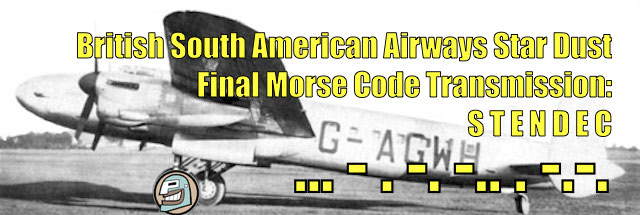The British South American Airways (BSAA) Avro Lancastrian airliner (registration G-AGWH) took off from Buenos Aires, Argentina enroute to Santiago, Chile on August 2, 1947.
Star Dust’s final Morse code transmission to Santiago airport, S T E N D E C, was received by the control tower four minutes prior to its planned landing and repeated twice:
… – . -. -.. . -.-.
… – . -. -.. . -.-.
The Morse transmission sounded just like this:
Star Dust — like Malaysian Airlines Flight MH370 and Argentina’s Cadet Flight — was never heard from again.
And what does S T E N D E C mean? No one knew then, no one knows now.
The flight left Buenos Aires at 1.46 PM on 2 August and was apparently uneventful until the radio operator (Harmer) sent a routine message in Morse code to the airport in Santiago at 5.41 PM, announcing an expected arrival of 5.45 PM.
However, Star Dust never arrived, no more radio transmissions were received by the airport, and intensive efforts by both Chilean and Argentine search teams, as well as by other BSAA pilots, failed to uncover any trace of the aircraft or of the people on board.
The head of BSAA, Air Vice Marshal Don Bennett, personally directed an unsuccessful five-day search.
A report by an amateur radio operator who claimed to have received a faint SOS signal from Star Dust initially raised hopes that there might have been survivors, but all subsequent attempts over the years to find the vanished flight failed. In the absence of any hard evidence, numerous theories arose — including rumours of sabotage (compounded by the later disappearance of two other aircraft also belonging to British South American Airways); speculation that the flight might have been blown up in order to destroy diplomatic documents being carried by passenger Paul Simpson; or even the suggestion that Star Dust might have been taken or destroyed by a UFO (an idea fuelled by unresolved questions about the flight’s final Morse code message).
Wreckage of the plane was finally found in 1998, almost 50 years later.
- Hat tip to POCHO Consulting Aerospace Editor Mathew.

